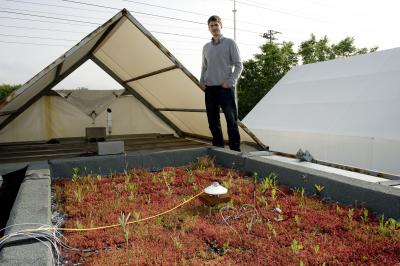Aitor Erkoreka, a UPV/EHU lecturer and researcher, has shown that green roofs are ideal for places where it is very hot in summer.
So, by means of these claddings less air conditioning is needed than with conventional roofs; the same degree of comfort is achieved and therefore energy consumption is reduced. However, a suitable irrigation system is essential to obtain good results.
Having plants on the roofs of buildings instead of the usual gravel offers a range of advantages. Beyond the aesthetic aspect, the existence of many buildings of this type prevents the formation of an island of heat in towns and cities, and reduces the risk of floods in the rainy season. What is more, green roofs usually support many animal species and are useful for tackling atmospheric and acoustic pollution.
Aitor Erkoreka, a PhD holder in thermal engineering from the UPV/EHU, has studied whether they are advantageous from the thermal energy perspective, and has confirmed that they are suitable in some cases, but not all.
This was in fact the subject chosen for his thesis: to compare green roofs with gravel ones in terms of their thermal and hygroscopic behaviour. It was in fact a building contractor that wanted to carry out a study into the two kinds of roofing for a prefabricated modular construction project. The units measuring 6.6m long, 3.3m wide and 3m high, are mass produced and assembled at the final destination (buildings of up to 8 floors can be built). Erkoreka used the Paslink methodology to conduct the study of the two roofing types and carried out experiments under extreme meteorological conditions.
That way he was able to show that there are basically two factors that make green roofing useful on an energy and economic level. Firstly, in the place where the building is located the use of cooling systems has to be extremely necessary, and secondly, the roof must have a suitable irrigation system.
Evapotranspiration is the key
Erkoreka conducted simulations in different climates and observed that in very sunny places the plant roofing is more effective than traditional insulation to protect against the interior heat of the houses.
According to the researcher, this is due to the evapotranspiration of the plants: “In summer, a considerable proportion of the solar energy entering houses does so through the roof. However, if we landscape a roof that already has traditional insulation, to a certain extent we can prevent the house from heating up. Plants absorb water through their roots and release water in the form of vapour through their leaves. And they get the energy they need for this from the sun. That way, rather than getting inside houses, solar energy is used by the plants for photosynthesis and evapotranspiration. That prevents the temperature on the outside surface of the house from rising. According to the data obtained by Erkoreka, with this method the heat that gets into buildings through the roof can be reduced by 75%, resulting in reduced use of cooling systems.
But, as Erkoreka points out, it is “essential” that the plants are watered: “We have seen that in very sunny places and in the absence of rain the green roof dries out completely within a week unless it is watered (with a green roof about 10cm thick or less and most of them have these features). And in that case it is of no use whatsoever. What is more, the plants and earth absorb radiation better than gravel so the need for cooling systems increases.” Specifically, a dry green roof can increase the need for cooling by 65% compared with a traditional roof.”
That is why Erkoreka has also taken into account the cost of irrigation when comparing the green roof with the gravel one. And he has reached the conclusion that more savings are made in the consumption of a cooling system than through what is spent on the watering system. In other words, from the economic perspective, in places that have very hot summers, it is worthwhile having a green roof fitted, despite the fact that it needs watering and proper care.
However, the researcher believes that in winter it is not so advantageous. “In winter we’re after the opposite; in other words, we don’t want the heat to get out. During that season the plants are not very active, the earth tends to be damp because it usually rains. That makes the external surface of the roof colder than if it had no earth, so the heat loss with a green roof may be greater than with a traditional one.” So the use of a landscaped roof is only recommended in places with mild, fairly dry winters.
Erkoreka sums up the results of his thesis thus: “Just bearing in mind the thermal functioning of the roof, in places where it is not too hot in summer, it is not a good idea to have a green roof fitted, because it would be cheaper to have insulation that is 1 or 2 cm thicker both in the summer and in the winter. But in very sunny places where there is a great need for cooling, a green roof is recommended as it would reduce the demand for cooling considerably. Finally, he points out that a suitable watering system is necessary.



hello!,I love yourr writing so much! proportion we keep up a
correspondence more approximately youur article on AOL? I need an
expert in this house to solve my problem. May be that’s
you! Having a look forward to see you.
There are several roof coatings that are white. The highly reflective coating keeps the roof from getting so hot in the first place. Then insulate and ventilate.
It can be a daunting task to find roofing in south jersey. After a long time of searching I have finally found a company I enjoy using. They fixed my home and the job looks fantastic.